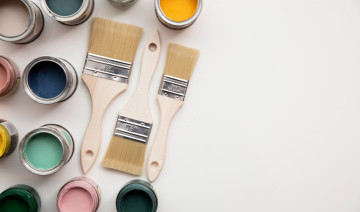Embarking on a painting project is an exciting endeavor that can breathe new life into your space. However, the success of your project hinges on more than just choosing the right paint color. Selecting the correct tools is equally vital to achieving a professional and polished finish. In this blog post, we'll guide you through the process of picking the right tools for your painting job, ensuring that every stroke contributes to a masterpiece.
1. Know Your Surface:
Understanding the surface you'll be painting is the first step in choosing the right tools. Different surfaces require different approaches. For smooth surfaces like drywall, rollers are often efficient, while brushes excel on textured surfaces. Identify the material of the surface—wood, metal, or masonry—and choose tools designed for optimal adhesion.
2. Consider the Type of Paint:
The type of paint you're using influences your tool selection. For water-based paints, synthetic brushes and rollers are ideal, as they won't absorb too much water. Oil-based paints, on the other hand, work well with natural bristle brushes and high-density rollers. Ensure compatibility between your paint type and the tools you choose.
3. Brushing Up on Brushes:
Selecting the right brush is crucial for achieving precision and a smooth finish. Consider the bristle type:
- Natural Bristle Brushes: Ideal for oil-based paints and varnishes.
- Synthetic Bristle Brushes: Best for water-based paints, providing a smooth finish.
Choose the brush size based on the surface area you're painting. Larger brushes are efficient for broad strokes, while smaller brushes are excellent for detail work.
4. Rolling Along:
Rollers are efficient tools for covering large areas quickly. Consider the following when choosing a roller:
- Nap Length: Short nap (1/4 inch) for smooth surfaces, long nap (3/4 inch) for textured surfaces.
- Material: Synthetic rollers for latex paints, and natural fibers for oil-based paints.
Roller frames with extendable handles make it easier to reach high or challenging areas.
5. Edging Tools:
Achieving clean lines and edges is crucial for a professional look. Use painter's tape for straight lines. For more precision, consider edging tools like an angled brush or an edging pad. These tools make it easier to cut in along corners, ceilings, and trim.
6. Spraying Solutions:
For large projects or uneven surfaces, a paint sprayer might be the tool of choice. Sprayers provide a smooth and even finish but require careful masking and protection of surrounding areas.
7. Prep and Cleanup Tools:
Don't forget tools for preparation and cleanup:
- Drop Cloths: Protect floors and furniture.
- Paint Tray: For easy access to paint during the job.
- Paintbrush Comb: Keep your brushes in top condition by combing out excess paint and cleaning them thoroughly after use.
8. Personal Comfort:
Consider your own comfort and preferences. Extension poles can make reaching high areas easier, and ergonomic handles on brushes and rollers reduce hand fatigue during extended use.
Choosing the right tools for your painting job is a nuanced process that involves considering the surface, paint type, and the level of precision required. By understanding the characteristics of different tools and matching them to the specifics of your project, you ensure that each stroke contributes to a finished product that reflects your vision. Whether you're touching up a room or taking on a larger project, the right tools are the brushes and rollers that bring your space to life with color and vibrancy.






Comments